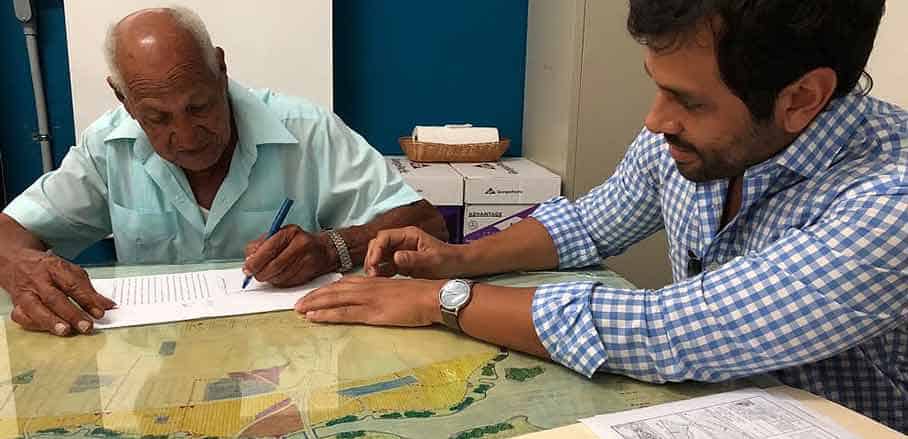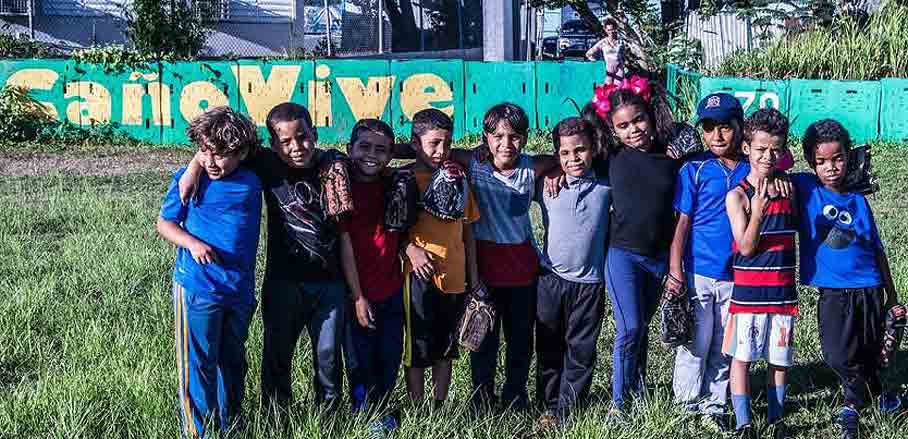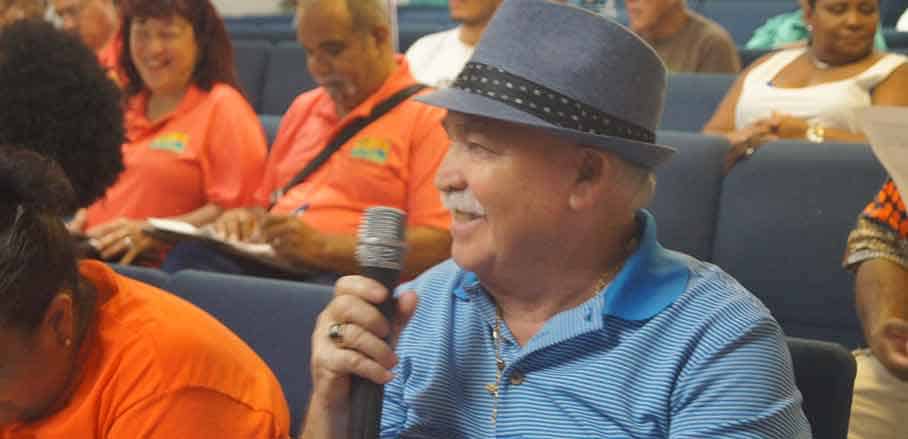By the People, For the People: Social and Environmental Revitalisation of the Caño Martín Peña, Puerto Rico
Improving the living conditions in low-income communities always entails the threat of gentrification processes, eventually displacing the original residents. Lorena Zárate claims that this is not an inevitable outcome, as can be seen in the success of the Caño Martín Peña Land Use Plan.
Poor, displaced communities, settled in degraded and risk-prone areas. Communities that have consolidated over time, due to residents’ individual and collective efforts to make their dreams and their rights a reality. Invisible, silenced, forgotten communities, threatened by public and private actors who justify eviction and displacement in the name of “development” and “sustainability”. A familiar history, which has been repeated over and over again, for millions of people, in countless places around the world. The Caño Martín Peña settlement in San Juan, Puerto Rico, could have been just another one on that list, but it decided to be different.
A Settlement (Un)Like Others
Located at the heart of Puerto Rico’s capital, the Caño Martín Peña is a tidal channel, six kilometres long. Its banks are the home of nearly 26,000 inhabitants, spread across eight communities. More than fifty per cent of them live below the poverty line, the average income is half the country’s, and the unemployment rate is high. Meanwhile, their neighbours are some of the city’s fancier financial and residential districts.
During the peak of the urbanisation process in the mid-20th century, individuals and families migrated from difficult living conditions in the countryside. As in many other Latin American cities, a growing economy was not paired with appropriate land and housing policies, leaving thousands of people without access to adequate and affordable housing. They arrived with limited material resources and established precarious homes in these publicly owned wetlands.
Between the 1960s and 1980s, the area was subject of an “urban renovation” policy that aimed at creating a “model city”. Settlements were dismantled, 30,000 people displaced. Some were resettled to public housing projects in other districts – designed to be transitory, but turning out to be permanent. The lands were then used for major infrastructure projects, government and private sector offices, and middle and high-income residences. There were more plans and projects proposals for the construction of hotels, marinas, and gardens – all of them involving the displacement of the existing communities – that were not implemented.
Aware of the lack of other formal options offered to low income families, government administrations eventually changed their approach: it provided the remaining settlements with some of the needed infrastructure and services. Under official programmes usually linked to political campaigns and electoral cycles, individual property titles were given to selected families. Nevertheless, proper sewage systems are still pending today, provoking serious contamination, recurrent flooding, and severe health problems.
Similar stories can be easily found in cities across the globe. So, what is it that makes the Caño Martín Peña such a unique and interesting case? It is the combination of specific planning tools and the guarantee of permanence, social justice, and improvement of living conditions for low-income residents.
Revitalisation with Social Justice: Participatory Integral Planning and Key Tools for Implementation
In a participatory process and with the support of a broad network of individuals and institutions, residents developed the Comprehensive Development and Land Use Plan (CDLUP). The vision was the creation of a “united, safe, and prosperous community”. The document, formally approved by the governor in 2007, contains goals, targets, and concrete measures aimed at the socio-economic revitalisation of the Caño Martín Peña neighbourhoods and at its physical integration with the rest of the city.

© Caño Martín Peña Community Land Trust
A fundamental part of the Plan was the previous approval of a national law, promoted by citizens, that created a legal basis for the work of three key actors: the G-8 Inc., the ENLACE Caño Martín Peña Project Corporation (ENLACE), and the Community Land Trust (CMP-CLT or Fideicomiso in Spanish).
The G-8
The G-8 is a non-profit organisation that consists of the leaders of 12 grassroots organisations from the eight communities along the Martín Peña channel. They bring together community-based, civic, and recreational organisations working in the area. The G-8 dispatches candidates from these neighbourhoods for the ENLACE Project Board (appointed by the Governor). Thus, the community has direct access to public funding and control over how the planning and revitalisation tools – including the Community Land Trust – are implemented.
ENLACE
ENLACE was designed by the community to be the implementing institution of the CDLUP. In partnership with public and private institutions, including universities and foundations, it is currently working on several initiatives aimed the social and environmental revitalisation of the channel. Under the leadership of the involved communities, dozens of activities – including education, income generating, sport, and recreation – are being promoted, in particular with children, young people, and the elderly. Food sovereignty, environmental awareness, reduction of violence, and women’s participation are among the topics covered. ENLACE is a key agency in the resettlement processes that the dredging of the channel entails, guaranteeing that affected families have access to alternative housing within the area. Currently, this institution is also managing the reconstruction process of houses and infrastructure that have been affected by hurricane Maria in September 2017.

© Caño Martín Peña Community Land Trust
The Community Land Trust
The Caño Martín Peña Community Land Trust (CMP-CLT) is a private, independent, and non-profit entity that maintains the collective ownership over the 80 hectares that host the communities. Its board is composed of eleven representatives, six of whom are community residents, three from government institutions, and two more non-residents appointed by the board as a whole. Its goal is to avert gentrification’s negative impacts that can be expected as a result of the undergoing revitalisation projects. One important aspect in this regard is the formalisation of property and land use rights through the “surface rights”. Around 2,000 families are currently in the process of receiving full property rights over the buildings they are occupying and use rights over the plots where they are located). The property of the land remains under collective control in perpetuity.
These measures allow individuals and families easier access to loans and construction permits, which are necessary to make improvements to their homes. As a result of the private and public investments, the land value increases. Thanks to the collective ownership and other mechanisms, this process benefits the community as a whole, avoiding the threat of displacement in an area facing rapid transformation and gentrification. Besides clarifying the legal arrangements to guarantee land and housing rights for the inhabitants, the CMP-CLT is in charge of finding alternative housing for families that need to be removed, renting available buildings as well as constructing new houses on vacant plots (featuring renewable energy and rainwater sustainable management systems). For these purposes, it is also allowed to acquire land outside the district.
Political and Legal Challenges
Despite a detailed legal framework, and notwithstanding the will and commitment of a broad range of actors, the Plan’s effective implementation had to overcome some serious challenges during its initial steps. From the beginning, the entailing laws faced the opposition of certain governmental agencies. Once approved, some officials attempted to modify the district limits in order to maintain high-value land under their control; they even created amendments to prevent any land transfer. It took the communities and their allies four years of strong mobilisation to overcome these impediments. The issue became a central one on the national agenda, and eventually most sectors manifested their support of the people’s struggle.
Once the CMP-CLT could finally starts its operations, it confronted several legal and operational challenges, in particular regarding land registration. These were caused by a lack of sufficient, clear, and accessible information; public agencies intentionally delayed and obstructed the process. The CMP-CLT is currently working hard to establish a computerised system that will update and clarify the situation of its land inside the national cadaster.
A Project to Learn From
While an external evaluation of the impacts is still pending, the initiative has been the recipient of several national and international acknowledgments, including the Paul Davidoff Award for Social Change and Diversity (2009), the National Achievements in Environmental Justice Award (2010), the Roberto Clemente Medal (2014) and the World Habitat Award (2015). It was also the subject of a case study at the John. F. Kennedy School of Government at Harvard University and a recent publication by the Lincoln Institute for Land Policy.
At the same time, representatives from the communities have extensively participated in media interviews and exchanges with organisations in the USA, Latin America, and Europe. Their knowledge and experience are now inspiring and informing similar projects within Puerto Rico and beyond, showing that social and environmental revitalisation by and for the people is not only urgent, but certainly possible.

© Caño Martín Peña Community Land Trust
Over the past few years, national governments represented at the UN General Assembly have ratified their human rights obligations and their commitments towards sustainable economic and social development. The right to the city, the social function of land and the substantive community participation in urban development and revitalisation projects are key components of the New Urban Agenda and the 2030 Agenda. Bold and innovative measures, tools and mechanisms, like the ones offered by the Caño Martín Peña case, will be necessary to achieve these goals in the context of globally increasing urbanisation, precarisation, and inequality.
